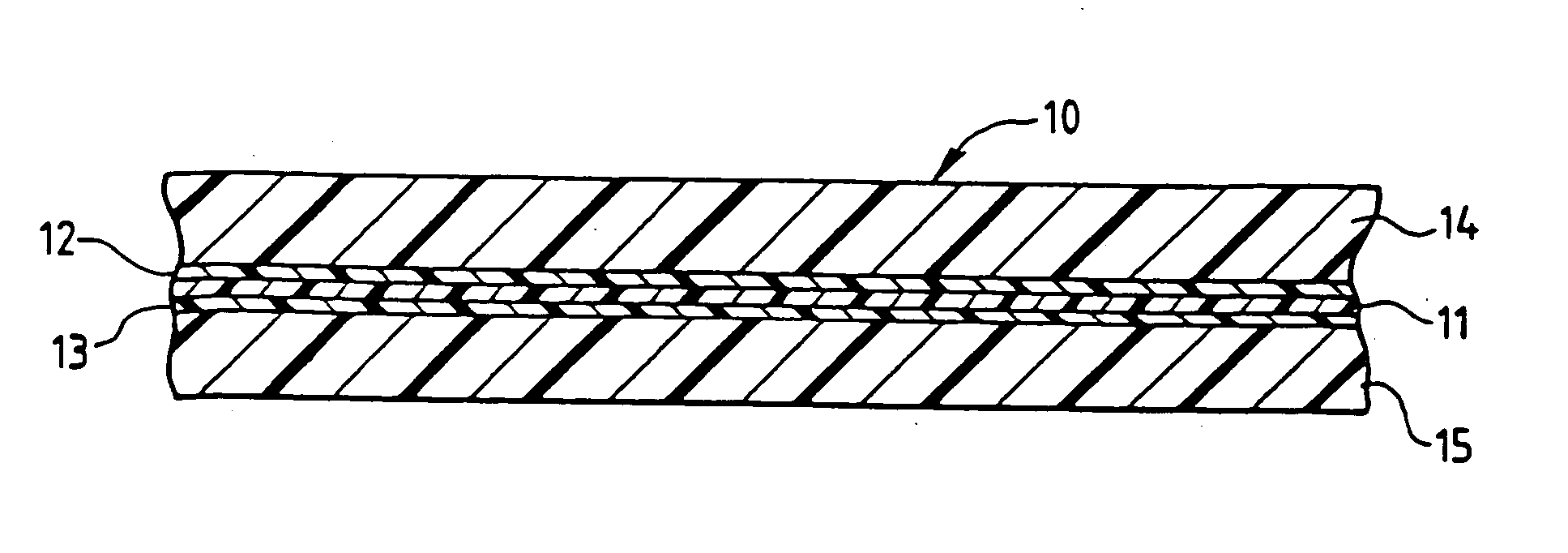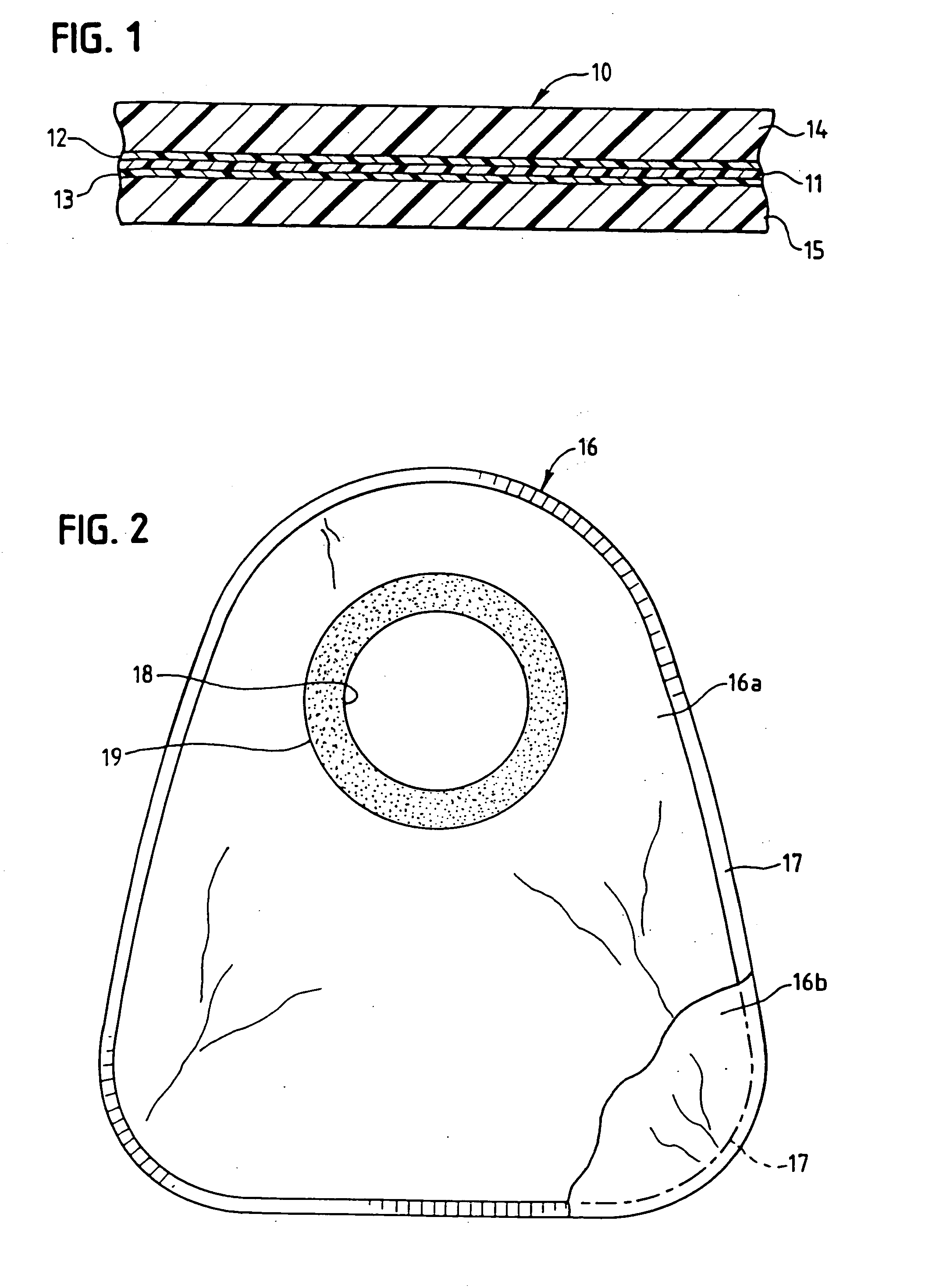Multilayer chlorine-free film with barrier layer of a polyamide blend and ostomy pouches formed therefrom
- Summary
- Abstract
- Description
- Claims
- Application Information
AI Technical Summary
Benefits of technology
Problems solved by technology
Method used
Image
Examples
example 2
[0027] A five-layer film was produced in accordance with this invention by coextrusion casting, resulting in a film with a total thickness of 3.3 mil and a barrier layer thickness of 0.32 mil. The film structure was A / B / C / B / A, where A was a polyethylene-based resin (Exact 8201, Exxon Chemical Co.) modified by the addition of 5% of a slip / antiblock concentrate (EXT4226TSE, A. Schulman Co.) and 3% of a low-density polyethylene (LD200.48, Exxon Chemical Co.). B are tie layers consisting of anhydride-modified ethylene vinyl acetate copolymer (Bynel 3861, DuPont Co.), and C is a blend of amorphous nylon (Selar PA3426) with an anhydride-modified ethylene octene copolymer (Fusabond MN493D) at 85% to 15% weight ratio.
[0028] The film was tested for quietness by forming a 4 inch by 4 inch sample into a cylinder and mounting it on a test fixture wherein one end of the cylinder was held fixed and the other was rotated around the cylinder axis at an angle of 15 degrees at 70 cycles per minutes. ...
example 3
[0030] A five-layer film was produced in accordance with this invention by coextrusion casting, resulting in a film with a total thickness of 3.2 mil and a barrier layer thickness of 0.28 mil. The film construction was A / B / C / B / A, having the same composition as the film of Example 2 except that the tie layers B were polyethylene-based (Bynel 41E557, DuPont Co.). The film was tested for quietness as described in Example 2. Results are shown in the table below which includes a control sample of a commercial ostomy film having a chlorinated barrier layer of PVDC.
3 TABLE 3 Sample dBA dB, 8 kHz dB, 16 kHz Film of Example 3 65 51 45 Control Film 74 55 49
[0031] As in Example 2, the dBA and dB values at 8 and 16 kHz reveal that the film sample of Example 3 is considerably quieter than the control sample in which the core layer is PVDC.
example 4
[0032] The film of Examples 2 and 3 were tested for odor transmission using British Standard 7127, Part 101, Appendix G. Method for Determining Odor Transmission of Colostomy and Ileostomy Bag Materials, British Standard Institution, London. Both films passed the test, indicating that the modification of the nylon barrier layer does not have a detrimental effect on odor barrier properties of the films.
[0033] In addition, a quantitative test of the barrier properties of the film of Example 2 was conducted using three model compounds for fecal odor: dimethyldisulfide, indole, and skatole. For comparison, the same test was conducted on a commercial ostomy film with a chlorinated (PVDC) barrier layer. Analysis of effluent gases was conducted by gas chromatography using a flame ionization detector. Table 4 shows breakthrough times and concentration of each component in the effluent stream after 60 hours.
4 TABLE 4 Breakthrough Times, min Concentration at 60 hours Dimethyl Dimethy disulfid...
PUM
| Property | Measurement | Unit |
|---|---|---|
| Fraction | aaaaa | aaaaa |
| Fraction | aaaaa | aaaaa |
| Fraction | aaaaa | aaaaa |
Abstract
Description
Claims
Application Information
 Login to View More
Login to View More - R&D
- Intellectual Property
- Life Sciences
- Materials
- Tech Scout
- Unparalleled Data Quality
- Higher Quality Content
- 60% Fewer Hallucinations
Browse by: Latest US Patents, China's latest patents, Technical Efficacy Thesaurus, Application Domain, Technology Topic, Popular Technical Reports.
© 2025 PatSnap. All rights reserved.Legal|Privacy policy|Modern Slavery Act Transparency Statement|Sitemap|About US| Contact US: help@patsnap.com


